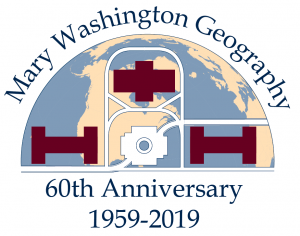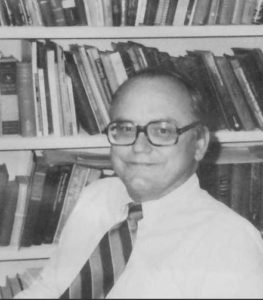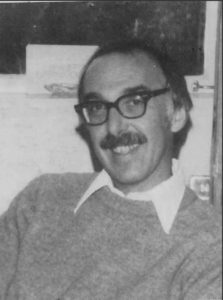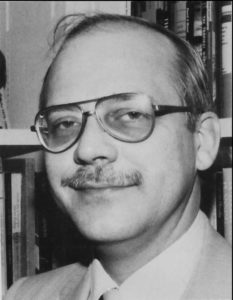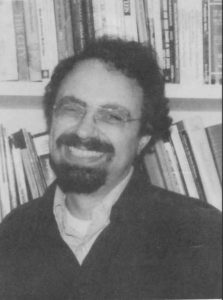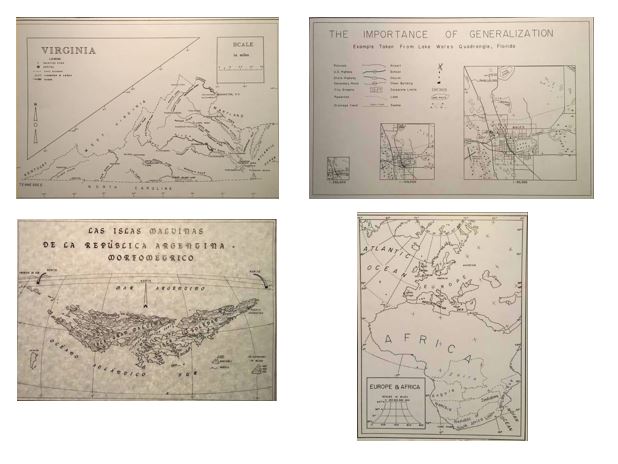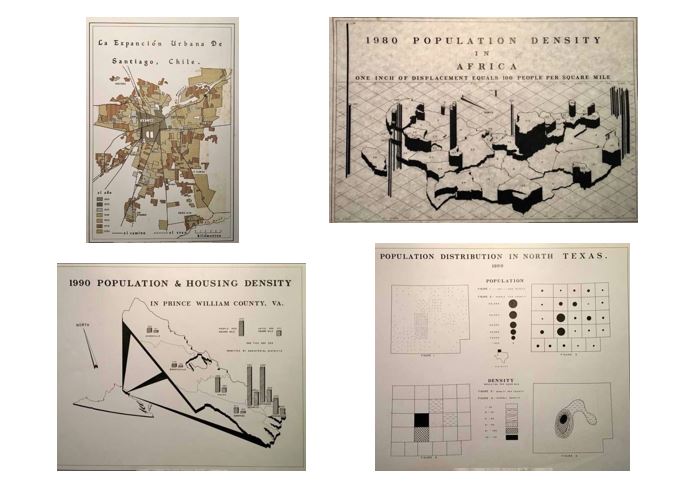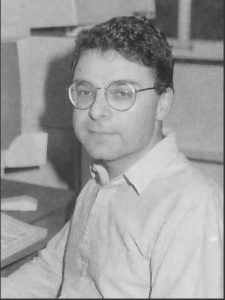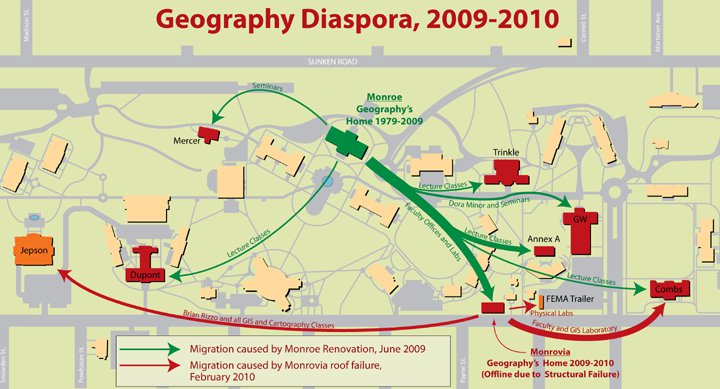A (more-or-less) definitive history!
Geography was always part of the curriculum at the Fredericksburg State Normal and Industrial School for Women, and at Mary Washington College. A major developed once Samuel T. Emory, the first full-time geographer, was hired. Sam Emory hired Sam Bird, a geologist, and together they established a Department of Geography and Geology in 1959. Their offices and classrooms were at the north end of Combs Hall, about where Department of Historic Preservation offices are today. Our first known major was (check with Stephen!), who graduated in 1963. The major had no real structure – a student would just take the courses offered until they had enough credits!
In 1965, Marshall Bowen was hired. He remembers being interviewed by Dean Alvey who offered a salary of $7,200 per year. Marshall was hired in part because he could teach an aerial photograph interpretation course; he had not quite completed his doctoral dissertation at Boston University. Ultimately, he taught the courses that Sam Emory didn’t want to teach: World Regional Geography, Air Photo Interpretation, Geography of Asia, Geography of Anglo America, Geomorphology, and Economic Geography. Marshall remembers there being a very small number of majors and small class sizes. There were perhaps 12 courses, including some in geology, with no structure to the major. Classes were taught on MWF and TR and Saturday, including some starting at 8:00 am! After a night of carousing, some young women would show up for class in their pajamas.
James B. Gouger III joined the faculty in 1969 and the three geographers moved into the basement of Monroe Hall, which at the time also housed the gymnasium. While still called the Department of Geography and Geology, the two disciplines functioned independently for a time before separating into two departments. The space that is now Monroe 116 was a big open gym with a piano for dance classes and a balcony with seating. Geography faculty offices were on a corridor along the level of the balcony.
Jim was hired to teach Cartography, a necessary skill, but he also introduced more structure to the program. World Regional Geography was required; Air Photo Interpretation was a pre-requisite for Cartography. Jim also taught the History of Geographic Thought, Geography of Latin America and Economic Geography.
A plaque in Monroe suite 310 shows that in 1971 25 majors chartered the Delta Mu chapter of Gamma Theta Upsilon, the international honor society in geography. Each year, many geography majors join this prestigious organization.
In 1971, Marshall offered the first summer field course to Wyoming’s Big Horn Basin, where his students were housed in the dormitory of Northwest Community College in Powell. The courses lasted six weeks, with two weeks of training on the way to Wyoming, two weeks there, and two weeks of exploration on the way home. Students did independent research projects were quite varied. One student worked with migrant sugar beet workers in and around Powell, another examined wild horse management at Pryor Mountain, and still another spent a week with a sheep herder and came back to town with him on his horse! These trips continued until 1978.
The multi-talented Marshall Bowen was coach of the MWC basketball team from 1974-76. Not surprisingly, a good half dozen of these players became Geography majors. Former players still gather twice a year to celebrate MW hoops at Snead’s Farm!
In 1978, a cultural geographer, Richard (Dick) Palmieri joined the Department. Dick had definite ideas on what a geography degree should look like and a more strategic approach to building the program. He developed an introductory Physical Geography course, which became a prerequisite for existing upper-level courses in Weather and Climate and Geomorphology, taught by Marshall, as well as a Cultural Geography course. The major now had some structure; certain regional and systematic courses were required for the degree. The number of geography majors grew to more than 20.
Monroe Hall was renovated in 1979-1980, during which time the Geography Department offices and classrooms moved to Goolrick Hall. Drs. Bowen, Emory and Palmieri shared an office, separated by bookcases; Dr. Gouger had his own office, in the cartography lab. Rumor has it that one semester Jim Gouger was told to have a larger number of students in his class, and overnight desks were moved and rearranged so that there wasn’t room for that many!
The Monroe Hall renovation incorporated space on the third floor designed by Jim, centered on the Cartography Lab (western side of the third floor, in the same space as it is today), with a dark room and a stereo-plotter room on either side of the main door. Dr. Gouger’s office led off from the north end into a suite with other faculty offices. A door at the south end connected to other offices, and the geography classroom – Monroe 301 – was in the space that is now Monroe 310, the ‘southern suite’ of faculty offices.
Back in Monroe (1980), Marshall regularly taught very large classes, commonly 90 students but sometimes 100 or 125, in the big lecture hall that is now Monroe 116. For five or six years, he would teach three sections per semester of the Geography of Eastern and Western North America (aka Anglo America), via lectures and slides. On the evening before a lecture, Marshall would go to the classroom and draw, with colored chalk, a map of the region to be discussed the next day. Students would copy the information onto an outline map they were given. Hundreds of Mary Wash students took his classes! Marshall attracted many students and the department swelled to 50-60 majors.
During President Woodard’s time (1974-82), when Mary Anne Byrnes was Dean of the College, several academic departments were consolidated (to streamline services and to save money) – for example economics and political science; geology, chemistry and physics. We became GAS: the Department of Geography, Anthropology and Sociology. Byrnes was not friendly toward geography; she considered geography and business to be “trades” rather than academic subjects! While short-lived, this consolidation was very unpopular with the faculty: Sam, Jim and Dick felt it was an affront to their independence. Separation occurred as soon as Woodard was no longer president (1982).
Dick was known for holding classes at 8 am and for constant teasing. Each morning he would go through his stack of index cards, randomly calling on a student to answer an impossible question. Within a few seconds, a flustered student would hear, Miss X were you out too late last night? He made the sound of a buzzer when time was up! His distinctive Boston accent added to his charm. Jim smoked cigarettes and held court in the Cart Lab at all hours of the night. One story has him throwing a computer out of a third floor window, only to have a student fetch it so he could throw it out again because it didn’t smash well enough. Students drew meticulous 3-D maps in ink on Mylar, proudly displaying them on Facebook to this day. Sam was known for his “biking through Europe” tours. During these, he would cook for the group and he was told he should open a restaurant. In 1981, he and his wife opened Fredericksburg institution Sammy T’s on Caroline Street, a bar and restaurant known for its eclectic menu, including vegan and vegetarian items.
Physical geography became a specialty with the hire of Jack Damron in 1988, who taught over Marshall’s Weather and Climate and Geomorphology classes, and offered Human Environment. Donald Rallis was hired in 1990 to teach World Regional Geography and the regional geography of Africa. He led a number of study abroad trips to different parts of the world, perhaps most notably to South Africa, where the group ran into, spoke with, and were photographed with Nelson Mandela! Donald was an early-adopter of technology, creating his own domain, using You Tube and teaching online before most others. An enthusiastic traveler, one of his best moves was to teach World Regional Geography online from around the world; students at Mary Wash attended class on their computers on campus, while Donald hopped across continents and time zones, showing live video and introducing them to the world.
In 1991, Joseph Nicholas was hired to replace Jack in the area of physical geography. Joe taught introduction to Physical Geography, Weather and Climate, and Geomorphology. Every summer, he traveled to his field site in the La Sal Mountains of Utah, bringing a student a long every couple of years; every winter, he regaled students with stories of the weather in Bemidji, Minnesota!
The academic year 1997-98 saw enormous changes in the department. Donald became chair. Sam Emory retired as planned, and was replaced by Erin Fouberg. Jim Gouger retired after his wife unexpectedly died, and Stephen Hanna was hired in a one-year position. Dick Palmieri became very ill and retired; his line was filled on a one-year basis by Dawn Bowen. The following year saw both Dawn and Stephen hired into tenure-track lines. Monroe Plaza was renamed Palmieri Plaza in 1997, after Dick’s death.
(Note that we don’t have anymore black & white photographs of our faculty!!)
Program changes followed with these new faculty. Erin specialized in Political Geography, taught Geography and Civilization, and Geography of Europe. Stephen started out teaching World Regional Geography (once!), Air Photo Interpretation, Cartography, and Economic Geography before helping to modernize the department through courses such as GIS & Cartography, Remote Sensing, Geography of Development, and Globalization & Local Development. Dawn taught Cultural Geography, History of Geographic Thought, and Latin America. She continued the Mary Wash tradition of study abroad, with trips to Costa Rica and Guatemala, and numerous semesters of Field Methods, which included Lancaster County, PA, Tangier Island in Chesapeake Bay, and Appalachia.
Marshall retired in 2001, and Farhang Rouhani was hired. Farhang is a very popular professor in Human Geography and has developed courses in Geopolitics, Migration Politics, and Geography of the Middle East. He occasionally leads small groups of students in the study of anarchy!
In 2003, Mary Wash recognized physical geography as a real science! Joe soon began teaching Physical Geography I and II, both with labs.
Erin departed for Northern State University, South Dakota, in 2003. Melina Patterson was hired in a one-year capacity, and on tenure track the following year. Melina taught Geography and Civilization, which the Dean asked the department to develop because there were not enough courses in one specific general education category. She soon developed a sequence in urban geography (Cities, Nature of Cities) and Race and Place in America.
In 2005, Mary Washington College became the University of Mary Washington.
In 2006 Jackie Gallagher was hired as a second physical geographer in part of a push for a 15:1 student faculty ratio. This meant that more sections of Weather & Climate and Landform Processes (Physical Geography I and II) could be taught – and that Joe could develop more specialized courses like Dynamic Climatology and Climate Change, while Jackie created offerings in Natural Hazards and Biogeography.
Brian Rizzo hired in 2007 to establish a certificate program in GIS; he originally worked on both Fredericksburg and Stafford campuses, switching to the main campus two years later. The GIS Certificate program began in 2008 and has grown steadily.
During the period 2009-2011 Monroe Hall was renovated for a second time and the Geography Department moved to “Monrovia”, as we fondly called Annex B, a trailer on College Avenue. Faculty offices were located around the edges of the trailer, with two central laboratories – one for physical geography, the other for GIS. Other classes were taught in various locations around campus. That first winter we had heavy snow and a slight sag in the physical lab ceiling became more pronounced. UMW Facilities decided that the roof really might collapse and told us to leave, resulting in “The Diaspora” where we moved out of Monrovia into a number of buildings on campus. Physical geography classes were taught in what was fondly called “the FEMA trailer” in the GW parking lot; GIS labs were taught in the basement of Combs Hall. Jackie, Dawn and Joe shared an office in Combs while others were in different buildings. During spring 2010, we moved back to Monrovia. Monroe Hall reopened in summer 2011 with the current configuration of classrooms, offices and labs, including the movable wall in the Cartography Lab.
Donald Rallis retired to Phnom Penh, Cambodia, in 2013. Caitie Finlayson was hired in a one-year position which became tenure-track in 2014. With a specialty in the Geography of Religion, Caitie also taught World Regional Geography and Human Geography; she developed a course introducing students to Quantitative Methods, and soon branched out into other cultural topics such as food production and consumption patterns.
2014 was a big year, in which Ping Yin joined the department and the Master of Science in Geospatial Analysis was started. The MSGA remains the only master’s program in the College of Arts and Science; it has about 30 active students taking courses in the evening in Monroe Hall. Ping teaches undergraduate and graduate GIS courses, with a research focus on health issues and web-GIS.
The success of the MSGA quickly led to the hire of Marco Millones-Mayer in 2016. Marco teaches undergraduate and graduate courses in GIS and remote sensing; his focus is on environmental policy and land use/land cover changes. He is teaching his first course on LULC in the fall. He hopes to attract international students to UMW and has joined Dawn in teaching the Grassroots Development in Guatemala course.
With the growth of the department to ten faculty members, we now have three office suites: on the third floor at the far northwestern and southwestern ends of the building, and in the northwestern corner of the basement in what was a classroom. Our computer laboratory is booked for classes every evening Monday through Thursday, and we teach in other computer labs in Monroe and around campus every night!
Read about our 50th Anniversary here (I’m afraid the videos have been lost…)
